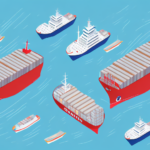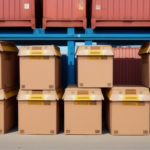Understanding Demurrage: What You Need to Know
If you’re in the business of importing or exporting goods, then understanding the concept of demurrage is crucial. It’s a commonly used term in the shipping industry that can significantly impact your supply chain management and logistics. In this article, we’ll provide a comprehensive overview of demurrage and everything you need to know to avoid unexpected costs and risks.
Demurrage Defined: A Comprehensive Overview
Demurrage is a fee charged by carriers and shipping companies for the delay of cargo beyond an agreed period of time, often due to storage or transportation issues. The precise definition and calculation of demurrage can vary depending on various factors, including the type of cargo, shipping routes, and carriers’ policies.
Demurrage fees can be a significant cost for businesses involved in international trade, especially if there are delays in the delivery of goods. It is important for companies to understand the demurrage policies of their carriers and to plan accordingly to avoid unnecessary fees.
In some cases, demurrage fees can be avoided by negotiating with carriers for extended free time or by using alternative transportation methods. However, it is important to weigh the costs and benefits of these options and to consider the potential impact on delivery times and overall logistics.
The History of Demurrage and Its Significance in the Shipping Industry
The concept of demurrage dates back to the 18th century, when merchants paid for the rental of vessels beyond the agreed time for loading and unloading. Since then, demurrage has become an essential aspect of the shipping industry, ensuring the timely release of goods and avoiding congestion and unnecessary costs.
In recent years, the use of technology has revolutionized the demurrage process. Many shipping companies now use digital platforms to track cargo movements and automate demurrage calculations. This has not only made the process more efficient but has also reduced the risk of errors and disputes between shippers and carriers.
How Demurrage Costs are Calculated and Who is Responsible for Paying Them
Demurrage costs are usually calculated based on a daily rate, starting from the agreed period for loading and unloading and continuing until the cargo is finally released. The responsibility for paying demurrage costs could fall on different parties involved in the shipment, including the shipper, consignee, or carrier, depending on the terms of the contract.
It is important to note that demurrage costs can quickly add up and become a significant expense for all parties involved. To avoid these costs, it is crucial to have a clear understanding of the terms and conditions of the contract before the shipment takes place. This includes having a realistic timeline for loading and unloading the cargo and ensuring that all necessary documentation is in order.
In some cases, demurrage costs may be waived or reduced if there are extenuating circumstances that caused the delay in the cargo’s release. However, this is not always guaranteed, and it is essential to have a contingency plan in place to mitigate any potential demurrage costs that may arise.
The Impact of Demurrage on Supply Chain Management and Logistics
Demurrage can have significant consequences on your supply chain management and logistics. It can cause delays in the delivery of goods, impact cash flow, and even lead to legal disputes. To avoid these issues, it’s crucial to have a clear understanding of demurrage and to incorporate it into your shipping plans and logistics.
One of the main causes of demurrage is inefficient communication between the parties involved in the shipping process. This can include miscommunication about delivery times, delays in obtaining necessary documentation, or failure to properly coordinate with port authorities. To mitigate these issues, it’s important to establish clear lines of communication and to ensure that all parties are aware of their responsibilities and deadlines.
In addition to communication issues, demurrage can also be caused by external factors such as weather conditions, labor strikes, or equipment failures. While these factors may be beyond your control, it’s important to have contingency plans in place to minimize the impact of these events on your supply chain. This may include alternative shipping routes, backup suppliers, or additional inventory to buffer against delays.
Tips for Avoiding Demurrage Charges and Minimizing Risks
Here are some useful tips for avoiding demurrage charges and minimizing risks:
- Choose the right mode of transportation for your cargo. Depending on the type of goods you are shipping, it may be more cost-effective to use air freight instead of sea freight, or vice versa. Consider the transit time, cost, and reliability of each option before making a decision.
- Understand the demurrage and detention policies of your carriers and ports. Different carriers and ports may have different policies and fees, so make sure you are aware of them before you book your shipment. This will help you avoid any unexpected charges and delays.
Examining Common Causes of Demurrage and How to Avoid Them
Some of the most common causes of demurrage include port congestion, customs clearance delays, documentation errors, and vessel breakdowns. To avoid these issues, it’s essential to work with reliable carriers and suppliers, plan ahead, and stay informed about the latest developments and regulations in the industry.
Another common cause of demurrage is inaccurate cargo weight or measurement. If the cargo weight or measurement provided by the shipper is incorrect, it can lead to delays in loading or unloading the cargo, which can result in demurrage charges. To avoid this, it’s important to ensure that the cargo weight and measurement are accurately measured and communicated to the carrier before the shipment.
Demystifying the Demurrage Process: A Step-by-Step Guide
The demurrage process can be complex and confusing. Here’s a step-by-step guide to help you understand it:
- Understand the terms of the contract and ensure that all parties involved are aware of their responsibilities and timelines.
- Ensure effective communication and planning to prevent delays.
It’s important to note that demurrage charges can add up quickly and significantly impact the cost of a shipment. To avoid demurrage charges, it’s crucial to have a clear understanding of the terms of the contract and to ensure that all parties involved are aware of their responsibilities and timelines. Effective communication and planning can also help prevent delays and minimize the risk of demurrage charges.
The Role of Technology in Demurrage Management and Prevention
The use of technology can help optimize demurrage management and prevent issues. For example, real-time tracking systems can provide visibility into the location and status of cargo, reducing the risk of delays. Automation tools can also help streamline workflows and eliminate errors that may lead to demurrage charges.
In addition to real-time tracking systems and automation tools, technology can also aid in demurrage prevention through predictive analytics. By analyzing historical data and identifying patterns, predictive analytics can help shippers and carriers anticipate potential delays and take proactive measures to avoid them. This can include adjusting shipping routes or schedules, or even rerouting cargo to avoid congested ports or terminals.
Another way technology can assist in demurrage management is through the use of digital documentation and communication. Electronic bills of lading and other digital documents can help reduce the time and costs associated with manual paperwork, while also providing greater accuracy and transparency. Additionally, digital communication tools such as email and messaging platforms can help facilitate faster and more efficient communication between all parties involved in the shipping process, reducing the risk of miscommunication and delays.
Case Studies on Successful Demurrage Management in Different Industries
Here are some examples of how different industries have successfully managed demurrage:
Demurrage vs Detention: Understanding the Difference and Implications
Demurrage is often confused with detention, another term used in the shipping industry. Detention refers to the charge for the use of a container beyond the agreed period. The key difference is that demurrage is charged for the delay of cargo, while detention is charged for the use of containers. Understanding the difference between demurrage and detention is crucial for avoiding unexpected costs and ensuring compliance with contracts.
The Legal Aspects of Demurrage: Contracts, Disputes, and Arbitration
The legal aspects of demurrage can be complex and challenging. Disputes over demurrage charges can lead to costly legal action, and it’s essential to have a clear understanding of your legal rights and obligations under the contract. In case of a dispute, arbitration can be a faster and more cost-effective means of resolving the issue.
How to Negotiate Favorable Demurrage Terms with Carriers and Suppliers
When negotiating demurrage terms with carriers and suppliers, it’s crucial to have a clear understanding of your shipping requirements and budget. Make sure to review and negotiate the terms of the contract carefully, including the demurrage charges, period, and responsibility. Also, be open to exploring alternative solutions, such as using different carriers or shipping routes.
Future Trends in Demurrage Management: Predictions for the Shipping Industry
The shipping industry is continually evolving, and so is demurrage management. Some of the future trends in demurrage management may include increased use of technology, more transparent pricing policies, and greater collaboration among stakeholders.
Practical Solutions for Reducing Overall Shipping Costs with Effective Demurrage Management
Finally, here are some practical solutions for reducing your overall shipping costs with effective demurrage management:
- Understand and plan for the specific requirements of your shipment.
- Choose reliable carriers and suppliers.
- Utilize technology for tracking and predictive analytics.
- Ensure clear communication and accurate documentation.
In conclusion, understanding demurrage and its implications is essential for anyone involved in the shipping industry. By following the tips and solutions outlined in this article, you can minimize risks, avoid unexpected costs, and optimize your supply chain management and logistics.




















